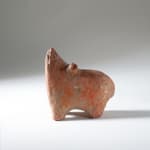Anonymous Sao artist
16th century or earlier
Terracotta
height 3 1/2 in
Further images
This wonderful abstract rendering of a hippopotamus originates from the so-called Sao Civilization, which developed over a millennium at the south-western shores of Lake Chad. The very term ‘Sao’ indicates the vagueness of our knowledge of this enigmatic culture, meaning in a pejorative Moslem usage ‘pagans’. While migrants from the north settled in Chad from the 5th century onwards, the great epoch of Sao culture, characterized by walled cities and elaborate funerary rites, was from the 10th to the 16th centuries. From this time date the many thousands of mostly ceramic objects that have yet to be coherently interpreted. Despite extensive archaeological research, especially by Marcel Griaule and Jean-Paul Lebeuf, details about the rise and fall of this culture remain unknown. Cultures who succeeded the Sao, such as the Kotoko, appropriated some of their artistic traditions and propagated legends about these powerful predecessors. Most known artworks have been found in dwelling, ritual, and funerary sites, as well as in areas identified as metallurgic workshops. Clay, iron, and copper were the media of choice for the Sao. They created animal and human figurines imbued with protective properties, and personal adornments such as rings, bracelets, and pendants. Over a period of several decades the French couple Jean-Paul Lebeuf (1907-1994) and Annie Masson-Detourbet (1921-1995) did extensive archeological research in the region; resulting in one of the few publications on the material culture of this region: “Lets arts des Sao” (Paris, 1977). Daughter to the French ambassador to Chad, Christine Liehman befriended the Lebeuf couple and build an important collection of Sao terracotta artworks over the years, the present hippopotamus being one of the masterpieces of the group. Too little is known about this culture to speculate about its significance, so we are left to enjoy its wonderful timeless abstraction. Characteristically Sao, the eyes are made from impressed pellets of clay, while the hippopotamus in his example is reduced to its essential shape; its head and snout projected upwards the sky.
Provenance
Collected by Christine Liehman in Chad during the 1960s-1970s
Yannick de Hondt, Bruges, Belgium, ca. 1998-2023
Duende Art Projects, Antwerp, Belgium, 2023







